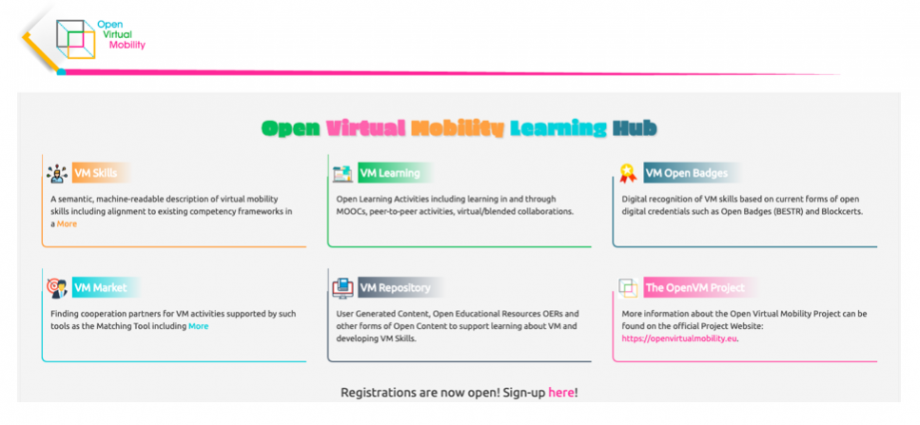NEW The Learning Hub has been launched: https://hub.openvirtualmobility.eu/ Students, teachers and education enthusiasts have now the possibility of self-enrollment on the platform and afterwards in the available courses.
To learn about the Learning Hub concept, functionalities, technical features/implementation and user cases, go to Output 2.
Open Virtual Mobility MOOC tutorial
Despite numerous projects on Virtual Mobility there is no single European Learning Environment acting as a central hub for learning about Virtual Mobility and developing VM Skills in HE. This Output is dedicated to designing, implementing and usability testing of an integrated Virtual Mobility Learning Hub for developing VM Skills using Online, Open & Flexible Higher Education Approaches and Practices.
The technical concept and the architecture of the VM Learning Hub incorporates the core components or services as described in O3, O4, O5 and O6:
- OpenVM Skills – a semantic, machine-readable description of virtual mobility skills including alignment to existing competency frameworks in a competency directory (O3);
- OpenVM Assessment – different forms of digital self-/assessment including digital evidence (such as testimonials, digital assets, e-portfolios, crowd evidencing) applied as elements of open credentials and supporting open, evidence-based assessment (O4);
- OpenVM Credentials – digital recognition of VM skills based on current forms of open digital credentials such as Open Badges and Blockcerts (O5);
- OpenVM Content – User Generated Content, Open Educational Resources and other forms of Open Content to support learning about VM and developing VM Skills (O6);
- OpenVM Activities – Open Learning Activities including learning in and through MOOCs, peer-to-peer activities, virtual/blended collaborations (O6);
- OpenVM Connections – finding cooperation partners for VM activities supported by such tools as the Matching Tool including an algorithm and interface for learning group formation and matching for collaboration of groups (O3);
- OpenVM Data – data about learning pathways and learning outcomes captured by xAPI and feeding into E-Assessment, Open Credentials and recommendations for learning.
The development of Virtual Mobility Learning Hub as a Personal Learning Environment (PLE) furthermore focuses on (a) the development of a responsive interoperable interface, (b) implementation of social software, (c) integration of tools for mobile learning, (d) development of a common working/collaboration space, (e) inclusion of adaptable and semantic features and learning analytics, (f) integrated self-assessment, and (g) validation of open digital credentials.
The development of the Virtual Mobility Learning Hub (VMLH) will imply an interdisciplinary approach from web technologies, mobile technologies, Web 2.0, interactive media and audio-video technologies, open access and tools to semantic technology. It will exist also in all partners’ languages (EN, DE, IT, NL, FR, ES, RO) with a possible extension to other languages which will allow communication at European, national and regional levels.
The Virtual Mobility Learning Hub is an innovative multilingual ICT-based environment unique in Europe (as an integrated semantic competency directory of virtual mobility attributes) will promote collaborative learning, connectivist social networking as an instructional method, OERs as the main content, open digital credentials as recognition and validation of VM skills which can be applied to all ages and levels of digital education.
The user-friendly interface as well as the mobile interface will encourage everyone to access it, engage in different open learning activities, connect with others and develop their VM competencies.



Comments are closed, but trackbacks and pingbacks are open.